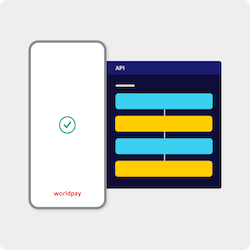Access Worldpay
Spend less time integrating and more time on your own product. Access Worldpay is built with a modern toolset and has code samples in the languages you use.
See the latest releases for all Access products.

| Payments API | Modular APIs | |
|---|---|---|
| Take payments that include a fraud assessment and 3DS authentication with one call. Let us handle the orchestration whilst retaining a high degree of customization. | Our suite of APIs that allow you to build your own payment journey based on your business needs. Take full control by tailoring your integration. Make separate FraudSight, 3DS and Card Payment API calls. | |
| Integration flows | Sequence Diagrams | Sequence Diagrams |
| Integration effort required | Medium | High |
| One-off payments | ||
| Cards | ||
| Fraud protection (3DS and FraudSight) | ||
| Apple Pay and Google Pay | ||
| Repeat payments | ||
| Recurring payments | ||
| Network token support | Coming Soon | |
| SCA Exemption support | Coming Soon | |
| Mail Order Telephone Order (MOTO) transactions | Coming Soon | |
| Alternative Payment Methods (APMs) | via APM API | via APM API |
| Payouts | via Payouts API | via Payouts API |
| Level of customization available | Full | Full |
| PCI compliance | Automatic with use of SDK | Automatic with use of SDK |
| Mobile support | Native | Native |
| Send for settlement | Automatically or Manually | Automatically or Manually |
| Geographical availability | Global | Global |
Core APIs/SDKs
Make a payment or payout with our core set of APIs
Modular APIs
Benefit from more control with our modular APIs. Perform a single risk check when using multiple payment providers, use our 3DS API as a standalone product or tailor your payment journey based on your business needs.

